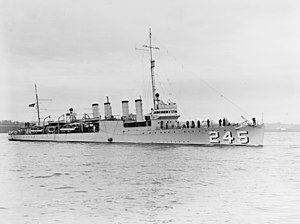 USS Reuben James on 29 April 1939
| |
| History | |
|---|---|
| Name | Reuben James |
| Namesake | Reuben James |
| Builder | New York Shipbuilding |
| Laid down | 2 April 1919 |
| Launched | 4 October 1919 |
| Commissioned | 24 September 1920 |
| In service | 24 September 1920 |
| Out of service | 31 October 1941 |
| Stricken | 25 March 1942 |
| Fate | Sunk by U-552 in the North Atlantic Ocean, 31 October 1941[1] 51°59′N 27°05′W / 51.983°N 27.083°W |
| General characteristics | |
| Class and type | Clemson-class destroyer |
| Displacement | 1,215 long tons (1,234 t) |
| Length | 314 ft 5 in (95.83 m) |
| Beam | 31 ft 8 in (9.65 m) |
| Draft | 9 ft 4 in (2.84 m) |
| Installed power | 26,500 shp (19,800 kW) |
| Propulsion |
|
| Speed | 35 kn (40 mph; 65 km/h) |
| Range | 4,900 nmi (5,600 mi; 9,100 km) at 15 kn (17 mph; 28 km/h) |
| Complement | 159 officers and enlisted |
| Armament |
|
USS Reuben James (DD-245) was a four-funnel Clemson-class destroyer that was constructed after World War I. She was the first United States Navy ship to be named after Boatswain's Mate Reuben James (c. 1776–1838), who had distinguished himself fighting in the First Barbary War, and was the first US Naval ship to be sunk by hostile action in the European Theater of World War II. Four US flagged merchant ships were also sunk by hostile action before Pearl Harbor.
Reuben James was laid down on 2 April 1919 by the New York Shipbuilding Corporation of Camden, New Jersey, launched on 4 October 1919, and commissioned on 24 September 1920. The destroyer was sunk by a torpedo attack from German submarine U-552 near Iceland on 31 October 1941,[1] resulting in the deaths of 100 crewmembers, before the United States had joined the war.
- ^ a b "Reuben James". Dictionary of American Naval Fighting Ships. Navy Department, Naval History and Heritage Command. 25 September 2005. Retrieved 11 April 2015.